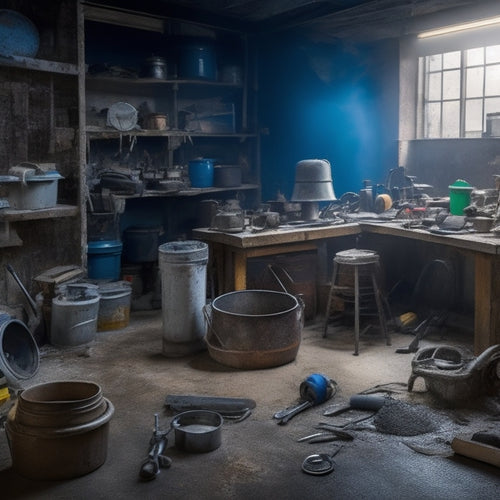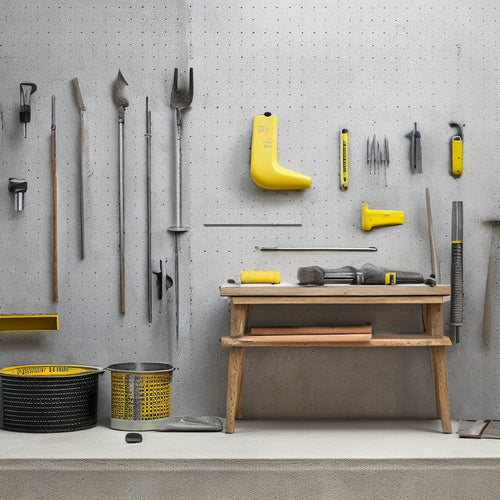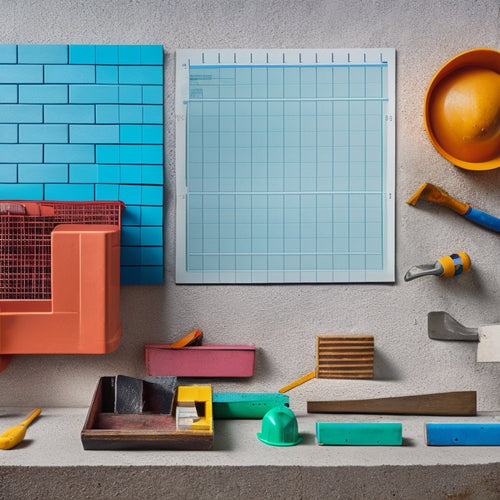
5 Best Safety Tools for Concrete Mixing Success
Share
When mixing concrete, you need the right safety tools to prevent injuries and guarantee success. Start with essential protective gear like long-sleeved shirts, steel-toed boots, and gloves to shield your skin from cuts and abrasions. Don't forget eye and face protection, including ANSI-compliant goggles and face shields, to safeguard against chemical splashes and impact. Chemical-resistant gloves, arm covers, and skin creams will reduce skin exposure risks, while dust masks and ventilation systems will protect your respiratory health. Finally, stabilize your mixing environment by monitoring weather conditions, maintaining equipment, and guaranteeing electrical safety. With these tools, you'll be well-equipped to tackle concrete mixing safely and effectively - and there's more to explore to assure your success.
Key Takeaways
• Wear steel-toed boots, long-sleeved shirts, and long pants to protect skin from injuries and rough concrete.
• Use ANSI Z87.1-compliant goggles or safety glasses with impact-resistant lenses to safeguard eyes from chemical splashes and debris.
• Don chemical-resistant gloves to prevent skin contact with harsh ingredients and abrasive materials.
• Implement dust masks or respirators to filter harmful particles from the air and maintain a safe breathing environment.
• Conduct regular inspections and maintenance of mixing equipment to ensure a stable and hazard-free mixing environment.
Essential Protective Gear for Mixers
When operating a concrete mixer, you must wear essential protective gear to prevent injuries from rotating parts, flying debris, and other hazards.
As you work with mixing equipment, it's important to prioritize your safety above all else. A thorough safety training program should be undertaken to educate you on the proper use of personal protective equipment (PPE) and the risks associated with concrete mixing.
During operation, you should wear long-sleeved shirts, long pants, and steel-toed boots to protect your skin and feet from injury.
Gloves are also a must-have to prevent cuts and abrasions from handling rough materials. Additionally, make sure your clothing is tightly fitted to prevent entanglement with the mixer's moving parts.
It's also essential to keep your hair and jewelry tied back to avoid any potential hazards.
Safeguarding Eyes and Face Protection
What kind of eye and face protection do you need to confirm your safety while operating a concrete mixer, where flying debris and chemical splashes pose a considerable threat?
To ascertain your eyes and face are protected from hazards, you'll need the right gear. Start with eye protection that meets the American National Standards Institute (ANSI) Z87.1 standards. Look for goggles or safety glasses with impact-resistant lenses and a secure fit.
For added protection, consider face shields that provide a barrier against chemical splashes and flying particles. These shields should be worn over your eye protection to create a thorough protective system. When choosing a face shield, make sure it's designed for use with your mixer and provides unobstructed visibility.
Don't compromise on quality – opt for face shields with a scratch-resistant coating and adjustable headgear for a comfortable fit. By investing in the right eye and face protection, you'll greatly reduce the risk of injury and confirm a safe mixing experience.
Preventing Skin Exposure Risks
Two critical areas of your skin that require protection from harsh concrete ingredients and abrasive particles are your hands and arms. As you handle concrete, the alkaline nature of cement and the abrasive particles can cause skin irritation, leading to redness, itching, and even burns. Consequently, it's crucial to take preventive measures to protect your skin from these hazards.
Here are some skin protection essentials to reflect on:
| Protection Method | Description | Effectiveness |
| Gloves | Wear chemical-resistant gloves to prevent skin contact with harsh concrete ingredients | High |
| Arm Covers | Use arm covers or sleeves to protect your arms from abrasive particles and splashes | Medium |
| Creams | Apply skin creams or barrier lotions before handling concrete to reduce skin irritation | Low-Moderate |
Reducing Respiratory Health Hazards
Protect yourself from inhaling hazardous concrete dust and particles by implementing proper respiratory protection measures, as the airborne contaminants can cause serious respiratory issues, such as silicosis and asthma.
When working with concrete, it's vital to prioritize air quality and take proactive steps to minimize your exposure to harmful substances.
Here are three essential respiratory protection measures to incorporate into your concrete mixing routine:
-
Wear a dust mask or respirator: These devices filter out harmful particles, ensuring you breathe in clean air. Make sure to choose a mask or respirator that's specifically designed for concrete dust and particles.
-
Use a ventilation system: A well-functioning ventilation system can greatly reduce the amount of airborne contaminants in your work area. This is especially important when working in enclosed spaces.
-
Implement dust-suppressing techniques: Wet concrete mixing, for example, can reduce the amount of dust generated during the mixing process. You can also use dust-suppressing sprays or foams to minimize airborne particles.
Ensuring Stable Mixing Environments
When mixing concrete, you must establish a stable mixing environment to prevent accidents and guarantee the quality of the final product, as unstable conditions can lead to compromised structural integrity and safety risks. A stable mixing environment guarantees that you can work efficiently and safely, without worrying about accidents or contamination.
To achieve mixing site stability, you need to take into account several factors, including:
| Factor | Description | Recommended Control Measures |
|---|---|---|
| Weather Conditions | Inclement weather can affect concrete quality and worker safety | Use canopies or tents to protect the mixing site from rain or sun |
| Ground Conditions | Unstable ground can lead to accidents and equipment damage | Guarantee the mixing site is level and compacted |
| Equipment Maintenance | Poorly maintained equipment can malfunction and cause accidents | Regularly inspect and maintain mixing equipment |
| Material Storage | Inadequate material storage can lead to contamination and accidents | Store materials in designated areas, away from the mixing site |
| Electrical Hazards | Electrical hazards can cause shocks and fires | Guarantee electrical equipment is installed and maintained according to safety standards |
Frequently Asked Questions
Can Concrete Mixing Be Done in Extremely Cold or Hot Temperatures?
When you're planning to mix concrete, you need to take into account the temperature effects on the process.
Extreme temperatures can greatly impact the final product's quality and safety.
In cold weather, you'll need to take precautions like using heated water, protecting the mixture from wind and cold, and accelerating the setting process.
On the other hand, hot temperatures can lead to rapid setting and reduced workability.
You'll need to adjust your mixing and curing techniques accordingly to guarantee a safe and successful concrete mixing process.
What Is the Recommended Frequency for Cleaning Mixing Equipment?
You think you can just mix and match (literally) without a care in the world? Think again!
You're probably aware that neglecting equipment maintenance can lead to catastrophic consequences.
When it comes to cleaning mixing equipment, you should be doing it daily, or at the very least, after every use.
Develop a routine that includes thorough cleaning techniques to prevent concrete buildup and guarantee smooth operations.
Are There Any Specific Safety Protocols for Mixing Different Concrete Types?
When mixing different concrete types, you'll need to adapt your safety protocols accordingly.
It's vital to undergo safety training that covers the unique hazards associated with each type, such as high-temperature risks with rapid-set concrete or chemical exposure with fiber-reinforced concrete.
Conduct thorough hazard identification to guarantee you're prepared for potential risks.
This knowledge will enable you to take necessary precautions, providing a safe working environment for yourself and your team.
Can I Customize My Personal Protective Equipment for Comfort?
Let's get down to business - you want to know if you can customize your personal protective equipment (PPE) for comfort.
Absolutely! You can tailor your PPE to fit your unique needs. Experiment with different PPE materials, such as breathable fabrics or ergonomic designs, to reduce discomfort.
Make comfort adjustments, like adjusting straps or padding, to guarantee a snug, secure fit. By doing so, you'll be more focused on the task at hand, rather than fidgeting with uncomfortable gear.
How Often Should I Replace My Safety Gear and Equipment?
You need to prioritize regular inspections and replacements to guarantee your safety gear remains effective.
Consider the safety gear longevity, as it varies depending on usage, storage, and manufacturer guidelines.
Create an equipment maintenance schedule to stay on track.
Typically, you should replace hard hats every 5 years, gloves every 6-12 months, and safety glasses every 2-3 years.
Always refer to the manufacturer's recommendations and industry standards for specific guidance.
Conclusion
As you stand amidst the dusty chaos of concrete mixing, remember that safety is just as vital as the final product.
On one hand, you're surrounded by the harsh realities of flying debris, toxic fumes, and treacherous terrain.
On the other hand, you hold the power to shield yourself from harm with the right gear.
By arming yourself with these five essential safety tools, you'll transform a hazardous work zone into a sanctuary of control, precision, and success.
Related Posts
-

7 Tools to Fix Damaged Concrete Floors
You're about to tackle that damaged concrete floor, and the right tools are essential for a successful repair. Start ...
-

10 Must-Have Tools for Concrete Repair Organization
You'll need a solid organization system to keep your concrete repair tools and materials within easy reach, protected...
-

Reinforcement Tools Checklist for Concrete Block Walls
You'll need a range of reinforcement materials, including horizontal and vertical rebar, fiber mesh, and anchor bolts...


